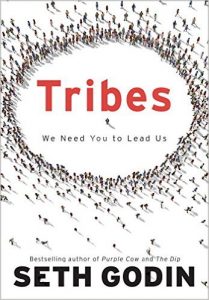Tribe: [noun] any group of people united by ties of descent from a common ancestor, community of customs and traditions, adherence to the same leaders, etc.
Do you want to know what tribal marketing looks like? Search out your closest Apple Store and go take a look.
 Back in 2011, the iPhone 4 was plagued by severe antenna problems that would cause customers of other phone brands to abandon ship and look for another company with a better product. Steve Jobs addressed the problem by telling users it was their fault for holding the phone the wrong way. But, even the most dissatisfied customers kept their phones because they believe that iPhones are the ‘best designed’ phones available and ‘Apple makes the best products.’
Back in 2011, the iPhone 4 was plagued by severe antenna problems that would cause customers of other phone brands to abandon ship and look for another company with a better product. Steve Jobs addressed the problem by telling users it was their fault for holding the phone the wrong way. But, even the most dissatisfied customers kept their phones because they believe that iPhones are the ‘best designed’ phones available and ‘Apple makes the best products.’
Fast forward to the launch of the iPhone 5s and the iPhone 5c. The trade press and popular press were underwhelmed with the latest gadgets from Apple. No standout features impressed the reviewers. The rumored low cost phone was actually pretty expensive. And, Steve Jobs was no longer around to wow everyone with his force of personality. It looked like Apple might finally have lost its Midas touch and many pundits were debating whether Apple should fire Tim Cook as CEO.
Launch day finally arrived.
Around the world, there were still people camped out in front of Apple stores waiting for the new iPhone. Lines wound around the block. The iPhone 5s and iPhone 5c launch broke all previous Apple sales records with an astonishing 9 million units sold over the first weekend (based on an approximate retail price of $650 that amounts to $5.8 billion.) They completely sold out of their initial stocks of phones.
The tribe had spoken! They want more iPhones and will pay a premium to get them.
The iPhone tribe forgave a defective iPhone 4 antenna and bought a new phone. Then they ignored dire reviews in the press and bought yet another new phone because they love the company and they love being part of the hip and cool tribe that pays a premium to own the ‘best designed’ products on the market.
That is tribal marketing operating in high gear.
Benefits of Tribal Marketing
Tribal marketing is about selling the experience of owning the products and the aura of being a member of a ‘select group’ once you own them. It’s not primarily about price, or features, or even value – it’s about the identity of a group, their big aspirational ideals, and a sense of belonging.
Tribal marketing is effective because it relies on some of the basic human psychology that gets manipulated by the people who start cults. This style of marketing focuses on the leader of the group, the lifestyle of those on the inside, and an attitude that people on the outside ‘just don’t get it!’ They even have their own language that is only understood by those on the ‘inside.’
When you market to a tribe you don’t sell a product, you sell a ‘lifestyle choice.’
How Tribes Form
 In his book “Tribes: We Need You to Lead Us”, Seth Godin says that you need 3 things to create a tribe: a common cause or passion, a way to communicate within the tribe, and a leader. Apple has all three elements. But there is even more going on in tribal marketing and, people trying to intentionally build a tribe, do more than Seth suggests when creating a solid enduring community.
In his book “Tribes: We Need You to Lead Us”, Seth Godin says that you need 3 things to create a tribe: a common cause or passion, a way to communicate within the tribe, and a leader. Apple has all three elements. But there is even more going on in tribal marketing and, people trying to intentionally build a tribe, do more than Seth suggests when creating a solid enduring community.
Some tribes are self organizing and develop organically. For example, an individual following a personal interest begins to interact with others who become inspired by his or her ideas. The discussion spreads, new people join in and that first person becomes a focal point in the community.
Other tribes are organized intentionally. This is generally the case with marketing tribes. A business will project a ‘big idea’ message into the market designed to attract people likely to buy their products. The community is nurtured and then products and services are marketed to them.
Virtual Tribes and the Internet
Until the advent of the Internet, geography was one of the primary constraints on creating tribes. Broadcast media could project the compelling message of an aspiring leader to a huge audience – the first two elements needed to create a tribe. But a way to communicate, the third essential tribe creation element that Seth Godin mentions, was missing. Before the Internet, potential tribe members could only connect with like minded people who lived close to them. In some cases, a nice sized tribe could be created. In other cases, it might not be possible to find even two people to gather around an idea.
The Internet opened up the communication lines. Suddenly, an aspiring leader could launch a website and share an idea with people around the world. As technology advanced it became possible to interact in real time through text, then images, audio, and video. Social media platforms followed that allow people to easily gather around multiple affinities and allowed leaders and tribe members to quickly jump into tribe-specific conversations.
The proliferation of smart phones has extended the reach of all of these communications tools to nearly every place you go. People now carry in their pocket or purse the ability to communicate through audio, video, text, and images to other members of the tribe. And, a savvy leader uses all available media to project a unifying and motivating message to the tribe.
Why Do People Join Tribes
So, what kind of person joins a tribe? People join tribes to become part of a group. To some extent, everyone joins a tribe of some kind – even if it is just being part of a family.
I Am a Tribe Member. It turns out that I’m a member of not one but two ‘marketing tribes’ – who knew?
Fortunately, I have been paying attention to how this happened and studying the tactics and techniques that lead me to join up in the first place.
I didn’t set out to become an expert in tribal marketing. My goal was to learn how to build an online business and I started seeking out people who were succeeding and then study what they did. Along the way I learned more than I expected.
Back in the winter of 2008 I joined Frank Kern’s Mass Control training program. I sat poised at my computer with credit card in hand waiting for the order page to ‘go live’. I did this to learn how an ‘evil marketing genius’ can get people to fall all over themselves trying to give him money. First I responded to a shared message that came from one of his affiliates. That led me to an interesting video presentation. That presentation convinced me to become a member of his email subscriber list and ultimately led me to purchase the Mass Control course he was selling.
Guess what? Frank Kern knows the psychology behind building a tribe and uses it with great skill to build a devoted group of people who want to buy things from him. I became a happy member of his tribe. Years later I still open the emails I get from Frank and watch many of the videos he creates – even if I am less inclined to invest in another marketing course.
Now, it is clear that Steve Jobs was a marketing genius. Frank Kern also has some amazing marketing skills. But, the cool thing is, you don’t have to be a marketing genius to build a profitable group of passionate followers. In fact, the first marketing tribe I joined was created by a very nice 60-something guy from New Jersey and I want to tell you his story to illustrate how a tribe is born.
How a Nice Guy from Jersey Built a Passionate Tribe
Dennis Becker is an incredibly nice and generous guy – the sort of fellow who would make Seth Godin smile, I think (Dennis is a huge fan of Seth.) His early career was spent as a computer programmer. He later started a small business selling collectibles in New Jersey. As eBay heated up as an online selling platform, Dennis began selling display cases and other collectible-related products online.
When Dennis attempted to jump to fulltime Internet marketing his early results were disappointing. He spent hours learning everything he could about marketing online and quickly became overwhelmed. He eventually connected with a mentor who asked him to commit to one strategy for enough time to get real results. It worked!
 After his initial rush of success, Dennis took time out and wrote an ebook called “5 Bucks a Day” to help other marketers develop a more focused approach to applying all the knowledge they were acquiring about Internet marketing. The book helped many people just like me start to break down their big dreams into smaller goals that would add up to a real business over time. And, it encouraged us to stay focused long enough to get results instead of hopping from idea to idea.
After his initial rush of success, Dennis took time out and wrote an ebook called “5 Bucks a Day” to help other marketers develop a more focused approach to applying all the knowledge they were acquiring about Internet marketing. The book helped many people just like me start to break down their big dreams into smaller goals that would add up to a real business over time. And, it encouraged us to stay focused long enough to get results instead of hopping from idea to idea.
In “5 Bucks a Day” Dennis shared his personal story of struggling to get traction for his online marketing business. He applied some ‘common sense wisdom’ to what he was doing and began to make progress.
Frank Kern teaches that one of the first things you should do to build a ‘tribe’ of your own is to tell them something they already know deep down, but present it as though it is a gospel revelation.
“5 Bucks a Day” taught people to stop hopping from one trend to another and focus on one small project that could make $5 per day until it was up and running. It wasn’t a sexy approach (no million dollar pay days), but it made sense. The gospel revelation was, “you are not succeeding because you don’t focus on one thing long enough to make any progress.”
Dennis shared his story because this shift in thinking really did change his business and make it much more profitable. But, it also had all of us who read it nodding our heads in agreement. Dennis validated something we all knew deep down, and he showed us that this was a path to real success.
The seeds were planted.
Dennis’ big idea was encapsulated in his ebook and “5 Bucks a Day” attracted like minded people and drew them into the tribe.
Dennis was actually a little bit surprised at how well the “5 Bucks a Day” ebook was received. There was no initial master plan for what to do next. He had a nice list of email addresses from customers and one day he announced that he was starting a free membership forum for owners of the ebook. The tribe now had a place to hang out and talk. We could also talk to Dennis (our leader) directly on a regular basis.
Very quickly the tribe started to develop a list of special abbreviations like 5BAD (5 Bucks A Day) as we spent hours discussing how we were applying our new found focus on our Internet marketing efforts. We were creating our own language.
Dennis participated every day in the discussions and gave us tons of free resources to help us improve our success. He encouraged members to ‘get out there’ and start doing things instead of just talking about them. He personally welcomed every new member and celebrated every success on the forum. He also pulled up short whenever someone asked him for details about exactly how he was making his major income – and we asked!
Then, one day, things got even more exclusive. Dennis started a new paid monthly membership forum called “Earn $1k a Day” where he ‘spilled his guts’ and gave us a step-by-step blueprint for making money using his (until now) secret process. He invited a small group of his most active members from the 5 Bucks a Day forum to join first and lay the groundwork for the rest who would follow.
This is a critically important step when creating a tribe. Your passionate first followers need to be trained to go out and recruit others. First followers are the key to rapid growth of the group. You need to praise and reward them when they bring in new followers and instruct them how to recruit more.
Now, all us freshly minted E1KAD (note the insider acronym) members began to follow our leader and the community grew. Dennis had built himself a passionate community of people who looked to him for inspiration and who now paid him a monthly fee to be part of the group.
The “Earn $1k a Day” membership site is still a great community and I’ve learned – and earned a good bit of money – since I joined up. The other members have supported my projects and I’ve benefited from the reports and software that are regularly posted for the members. Dennis hosted a number of live seminars at one point to gather the community together and the community has expanded to include a closed group on Facebook where much of the discussion takes place.
Dennis Becker ended up creating his own personal tribe around the notion of focusing small for big results and by nurturing a tribe who sees the world in a similar way. And now, it’s turned into a valuable business for him and spawned the successful careers of several other marketers.
It is safe to say that Dennis Becker did not set out to create his own E1KAD and 5BAD tribes. They grew organically from his success publishing the ebook and from the community he nurtured around that core idea of building up small successes to reach bigger goals. He gave a lot of time, energy, and content to his tribe and it grew into something pretty amazing.
7 Secrets of Successful Marketing Tribes
There is a method to the creation of a new tribe. For a marketing tribe to become successful they must share a common interest or need. The tribe must engage with one another and be willing take action when asked to do so. To truly become a tribe, the group needs to bond with one another and with the leader in a way that makes them feel like they are connected to real individuals and not an abstract label.
There are 7 key elements that combine together to create an effective and enduring tribe.
Successful Tribes Need:
- a Leader
- a Big Idea or Vision
- a Place to Gather
- a Unique Language
- Passionate First Followers
- Secret Knowledge
- Opposition
To better understand each of these 7 secrets, let’s break down the creation of Dennis Becker’s tribe of Internet marketers and see how each need was fulfilled.
Leader
Tribes have a leader. That leader sets the vision and ideals around which the group assembles. Dennis Becker became the central figure of his marketing tribes.
Big Idea or Vision
When Dennis published “5 Bucks a Day” he cast out his big idea that anyone could succeed online if they focused their efforts on completing simple projects instead of chasing the next shiny object promising instant success. He used his personal story to demonstrate that regular person could succeed.
Place to Gather
Historically, the ability to gather has been the limiting factor to tribal growth. But, the Internet changed all that. Now, people from around the world can connect with like minded individuals and form a tribe. Dennis culled his personal tribe from a larger one called the Warrior Forum – a large and active forum for Internet marketers. He did this by selling his ebook in their special offer forum. When he had acquired a large group of customers, he offered them an exclusive discussion forum where they could talk to each other and him.
Unique Language
Language is a bonding tool. Groups naturally form their own shorthand language. Religious groups have all sorts of specialized words that don’t mean much to outsiders. So do academics. So do skate boarders and surfers and lawyers and mommies, and countless others. That common insider language allows for easier communication, but it also helps identify insiders from outsiders.
Since Dennis’ group came together on text-based forums, they quickly built up shorthand acronyms like 5BaD, E1KaD, and MMS to replace “5 Bucks a Day”, “Earn 1K a Day”, and “Mini Money Sites” as they typed. Those added to the existing shorthand that was common to the wider Internet marketing audience and helped build a unique sub-group.
 Passionate First Followers. In his book “Herd – How to Change Mass Behavior”, Mark Earls notes that the most powerful way to influence group behavior is not to for the leader to persuade individuals but rather to convince a small group of passionate members to persuade each other. Derek Sivers gave a TED Talk where he broke down the process of starting a movement by analyzing an infamous YouTube video and showing just how important the first followers are to building a group.
Passionate First Followers. In his book “Herd – How to Change Mass Behavior”, Mark Earls notes that the most powerful way to influence group behavior is not to for the leader to persuade individuals but rather to convince a small group of passionate members to persuade each other. Derek Sivers gave a TED Talk where he broke down the process of starting a movement by analyzing an infamous YouTube video and showing just how important the first followers are to building a group.
In the case of Dennis Becker’s tribe, I was among the first followers. Dennis actively engaged the people on his 5BaD customer forum. A small group of us were extremely active and engaged. One day he contacted us privately and invited us into his new paid forum.
Dennis gave us first access to the new forum and also a special discount on the monthly fees. In exchange, he asked us to jump-start some conversations in the forum and give the place a ‘lived-in’ look. We enthusiastically complied and the early community on the forum was extremely vibrant. New members found answers to questions along with encouragement and other resources to help them succeed in their marketing efforts.
Secret Knowledge
One benefit of being a member of the tribe is access to resources that outsiders don’t have. This happened organically in Dennis’ tribe. He discussed his breakthrough marketing efforts in general terms in the original “5 Bucks a Day” book. But, he didn’t go into specifics to protect his profitable marketing campaigns from copycats. His first lure for joining the “Earn 1k a Day” forum was that he would reveal the details of how he was creating his profitable marketing campaigns. He called them Mini Money Sites, and walked us through the process of setting them up step-by-step. Soon, we were all copying the idea and trying it for ourselves (and several folks made some really good money at the time.)
As the site developed, Dennis branched out from that first idea and began to share more training resources with us. But that first insider knowledge set the hook.
Opposition
One thing that bonds a tribe together is opposition to outsiders. In the case of the “5 Bucks a Day” tribe, we were fighting against every marketer trying to sell us a new magic button product that would give us instant success. We came to see those sales pitches as distractions taking us away from our new-found focus. When we saw something that sounded promising, we came back into the community to discuss it. Some of us would purchase products and then report back on whether they would be useful or just a distraction.
Who Is Following You?
If you want real success for your Internet marketing business, you need to start thinking about building your own tribe/cult. You don’t have to swing for the fences to have real success that will fatten up your bank account. A few hundred devoted followers will go a long way.
Tribal Marketing Blueprint
- Establish a Leader
- Create Central Idea
- Build Content to Attract New Tribe Members
- Train and Empower First-Followers
- Invent Unique Language for the Tribe
- Learn their existing language patterns
- Introduce new words and acronyms
- Create a Discussion Platform
- How will they talk to you?
- How will they talk with each other?
- Create Insider Information to Share with the Tribe


